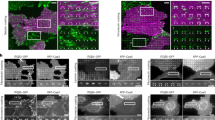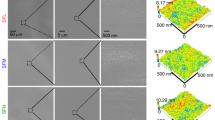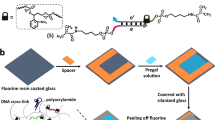Abstract
Cell adhesion on biomaterial surfaces has been extensively studied from the perspective of the adsorption properties of adhesive ligands, while recent research on mechanobiology has been revealing a critical role of the mechanical properties of the extracellular milieu in the control of cell adhesion, such as the stiffness and viscoelasticity of the matrix. Although the effects of the lateral mobility of an adhesive ligand have been intensively investigated in a model substrate with water-soluble polymer layers, less is known about those in the setting of lateral deformability of hydrophobic condensed polymer layers. In this study, to help clarify this issue, we used PNIPAAm-grafted substrates with a well-controlled degree of graft-polymerization (DGP) as a typical hydrophobic condensed polymer surface at a cell culture temperature of 37 °C. We observed a clear negative correlation between cell spreading and DGP of PNIPAAm regardless of the amount of fibronectin adsorbed on the substrates, which was found to be attributable to the lateral deformability of a condensed PNIPAAm layer based on lateral force microscopic analysis. The surface-lateral-deformation-induced modulation in stability and maturation of focal adhesion of the cells is discussed in relation to the matrix-strain-induced alteration of the density distribution of adsorbed adhesive ligands.
This is a preview of subscription content, access via your institution
Access options
Subscribe to this journal
Receive 12 print issues and online access
$259.00 per year
only $21.58 per issue
Buy this article
- Purchase on Springer Link
- Instant access to full article PDF
Prices may be subject to local taxes which are calculated during checkout






Similar content being viewed by others
References
Folkman J, Moscona A. Role of cell shape in growth control. Nature. 1978;273:345–9.
Singhvi R, Kumar A, Lopez GP, Stephanopoulos GN, Wang DIC, Whitesides GM, et al. Engineering cell shape and function. Science. 1994;264:696–8.
McBeath R, Pirone DM, Nelson CM, Bhadriraju K, Chen CS. Cell shape, cytoskeletal tension, and RhoA regulate stem cell lineage commitment. Dev Cell. 2004;6:483–95.
DiMilla PA, Stone JA, Quinn JA, Albelda SM, Lauffenburger DA. Maximal migration of human smooth muscle cells on fibronectin and type IV collagen occurs at an intermediate attachment strength. J Cell Biol 1993;122:729–37.
Chen CS, Mrksich M, Huang S, Whitesides GM, Ingber DE. Geometric control of cell life and death. Science. 1997;276:1425–8.
Ghosh K, Pan Z, Guan E, Ge S, Liu Y, Nakamura T, et al. Cell adaptation to a physiologically relevant ECM mimic with different viscoelastic properties. Biomaterials. 2007;28:671–9.
Winer JP, Janmey PA, McCormick ME, Funaki M. Bone marrow-derived human mesenchymal stem cells become quiescent on soft substrates but remain responsive to chemical or mechanical stimuli. Tissue Eng - Part A. 2009;15:147–54.
Geiger B, Bershadsky A, Pankov R, Yamada KM. Transmembrane extracellular matrix-cytoskeleton crosstalk. Nat Rev Mol Cell Biol 2001;2:793–805.
Elosegui-Artola A, Trepat X, Roca-Cusachs P. Control of mechanotransduction by molecular clutch dynamics. Trends Cell Biol 2018;28:356–67.
Kechagia JZ, Ivaska J, Roca-Cusachs P. Integrins as biomechanical sensors of the microenvironment. Nat Rev Mol Cell Biol 2019;20:457–73.
Chaudhuri O, Cooper-White J, Janmey PA, Mooney DJ, Shenoy VB. Effects of extracellular matrix viscoelasticity on cellular behaviour. Nature. 2020;584:535–46.
Engler AJ, Sen S, Sweeney HL, Discher DE. Matrix elasticity directs stem cell lineage specification. Cell. 2006;126:677–89.
Trappmann B, Gautrot JE, Connelly JT, Strange DGT, Li Y, Oyen ML, et al. Extracellular-matrix tethering regulates stem-cell fate. Nat Mater 2012;11:642–9.
Yang C, Tibbitt MW, Basta L, Anseth KS. Mechanical memory and dosing influence stem cell fate. Nat Mater 2014;13:645–52.
Yang C, DelRio FW, Ma H, Killaars AR, Basta LP, Kyburz KA, et al. Spatially patterned matrix elasticity directs stem cell fate. Proc Natl Acad Sci U S A 2016;113:E4439–E4445.
Huebsch N, Arany PR, Mao AS, Shvartsman D, Ali OA, Bencherif SA, et al. Harnessing traction-mediated manipulation of the cell/matrix interface to control stem-cell fate. Nat Mater 2010;9:518–26.
Chaudhuri O, Gu L, Klumpers D, Darnell M, Bencherif SA, Weaver JC, et al. Hydrogels with tunable stress relaxation regulate stem cell fate and activity. Nat Mater 2016;15:326–34.
Kuhlman W, Taniguchi I, Griffith LG, Mayes AM. Interplay between PEO tether length and ligand spacing governs cell spreading on RGD-modified PMMA-g-PEO comb copolymers. Biomacromolecules. 2007;8:3206–13.
Attwood SJ, Cortes E, Haining AWM, Robinson B, Li D, Gautrot J, et al. Adhesive ligand tether length affects the size and length of focal adhesions and influences cell spreading and attachment. Sci Rep. 2016;6:34334.
Gunnewiek MK, Ramakrishna SN, Di Luca A, Vancso GJ, Moroni L, Benetti EM. Stem-cell clinging by a thread: AFM measure of polymer-brush lateral deformation. Adv Mater Interfaces. 2016;3:1500456.
Heskins M, Guillet JE. Solution Properties of Poly(N-isopropylacrylamide). J Macromol Sci Part A - Chem 1968;2:1441–55.
Okano T, Yamada N, Sakai H, Sakurai Y. A novel recovery system for cultured cells using plasma‐treated polystyrene dishes grafted with poly(N‐isopropylacrylamide). J Biomed Mater Res 1993;27:1243–51.
Okano T, Yamada N, Okuhara M, Sakai H, Sakurai Y. Mechanism of cell detachment from temperature-modulated, hydrophilic-hydrophobic polymer surfaces. Biomaterials. 1995;16:297–303.
Kidoaki S, Ohya S, Nakayama Y, Matsuda T. Thermoresponsive structural change of a poly(N-isopropylacrylamide) graft layer measured with an atomic force microscope. Langmuir. 2001;17:2402–7.
Linhui L, Yang Z, Bo L, Changyou G. Fabrication of thermoresponsive polymer gradients for study of cell adhesion and detachment. Langmuir. 2008;24:13632–9.
Takahashi H, Nakayama M, Yamato M, Okano T. Controlled chain length and graft density of thermoresponsive polymer brushes for optimizing cell sheet harvest. Biomacromolecules. 2010;11:1991–9.
Zhao T, Chen H, Zheng J, Yu Q, Wu Z, Yuan L. Inhibition of protein adsorption and cell adhesion on PNIPAAm-grafted polyurethane surface: Effect of graft molecular weight. Colloids Surf B Biointerfaces. 2011;85:26–31.
Otsu T, Yoshida M. Role of initiator‐transfer agent‐terminator (iniferter) in radical polymerizations: Polymer design by organic disulfides as iniferters. Makromol Chem Rapid Commun 1982;3:127–32.
Nakayama Y, Matsuda T. Surface macromolecular architectural designs using photo-graft copolymerization based on photochemistry of benzyl N,N-diethyldithiocarbamate. Macromolecules. 1996;29:8622–30.
Kidoaki S, Nakayama Y, Matsuda T. Measurement of the interaction forces between proteins and iniferter-based graft-polymerized surfaces with an atomic force microscope in aqueous media. Langmuir. 2001;17:1080–7.
Harris AK, Wild P, Stopak D. Silicone rubber substrata: A new wrinkle in the study of cell locomotion. Science. 1980;208:177–9.
Xue C, Yonet-Tanyeri N, Brouette N, Sferrazza M, Braun PV, Leckband DE. Protein adsorption on poly(N -isopropylacrylamide) brushes: Dependence on grafting density and chain collapse. Langmuir. 2011;27:8810–8.
Dai W, Zheng C, Zhao B, Chen K, Jia P, Yang J, et al. A negative correlation between water content and protein adsorption on polymer brushes. J Mater Chem B. 2019;7:2162–8.
Hedayati M, Marruecos DF, Krapf D, Kaar JL, Kipper MJ. Protein adsorption measurements on low fouling and ultralow fouling surfaces: A critical comparison of surface characterization techniques. Acta Biomater 2020;102:169–80.
Lehnert D, Wehrle-Haller B, David C, Weiland U, Ballestrem C, Imhof BA, et al. Cell behaviour on micropatterned substrata: Limits of extracellular matrix geometry for spreading and adhesion. J Cell Sci 2004;117:41–52.
Liu W, Bonin K, Guthold M. Easy and direct method for calibrating atomic force microscopy lateral force measurements. Rev Sci Instrum 2007;78:063707.
Balaban NQ, Schwarz US, Riveline D, Goichberg P, Tzur G, Sabanay I, et al. Force and focal adhesion assembly: A close relationship studied using elastic micropatterned substrates. Nat Cell Biol 2001;3:466–72.
Arnold M, Cavalcanti-Adam EA, Glass R, Blümmel J, Eck W, Kantlehner M, et al. Activation of integrin function by nanopatterned adhesive interfaces. ChemPhysChem. 2004;5:383–8.
Schvartzman M, Palma M, Sable J, Abramson J, Hu X, Sheetz MP, et al. Nanolithographic control of the spatial organization of cellular adhesion receptors at the single-molecule level. Nano Lett 2011;11:1306–12.
Patla I, Volberg T, Elad N, Hirschfeld-Warneken V, Grashoff C, Fässler R, et al. Dissecting the molecular architecture of integrin adhesion sites by cryo-electron tomography. Nat Cell Biol 2010;12:909–15.
Acknowledgements
This research was supported by AMED-CREST under Grant Number JP20gm0810002 and by a Grant-in-Aid for Scientific Research (18H04167) from the Ministry of Education, Culture, Sports, Science and Technology (MEXT) of Japan.
Author information
Authors and Affiliations
Corresponding author
Ethics declarations
Conflict of interest
The authors declare no competing interests.
Additional information
Publisher’s note Springer Nature remains neutral with regard to jurisdictional claims in published maps and institutional affiliations.
Supplementary information
Rights and permissions
About this article
Cite this article
Masaike, S., Sasaki, S., Ebata, H. et al. Adhesive-ligand-independent cell-shaping controlled by the lateral deformability of a condensed polymer matrix. Polym J 54, 211–222 (2022). https://doi.org/10.1038/s41428-021-00577-w
Received:
Revised:
Accepted:
Published:
Issue Date:
DOI: https://doi.org/10.1038/s41428-021-00577-w



